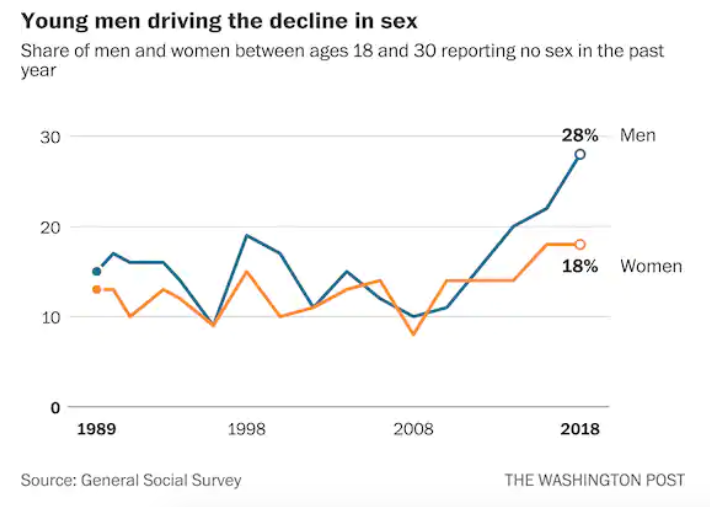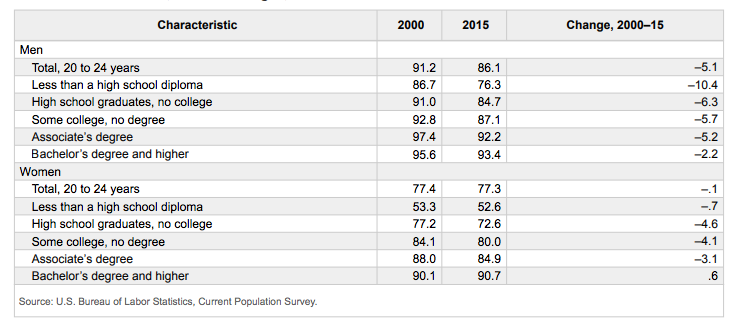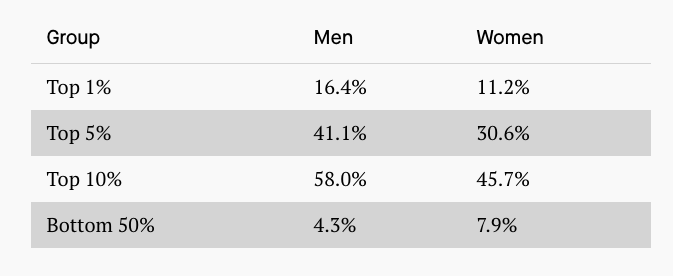Image credit: Tim Gouw on Unsplash.
If you spent any time doomscrolling this past weekend, you may have come across the following tweet:
bro this is an INSANE chart pic.twitter.com/ppi75a8RmE
— Ansem🃏 (@blknoiz06) March 20, 2021
The image in that tweet got spread around a lot, leading to rampant speculation about why, exactly, men are increasingly not having sex in their 20s.
The data itself comes from a March 2019 article in The Washington Post by Christopher Ingraham. It shares a number of data points from the General Social Survey, which found Americans overall are having less sex than they used to. Young people, in particular young men, appear to be driving this trend.

As per the chart below, the percentage of young women who hadn't had sex in the previous year increased as well, though not nearly as much as it did for men.

So, what happened starting in the late 2000s that sent this rate shooting upward? Here are the prevailing theories:
Theory #1: It's the economy, stupid
As Ingraham points out in his article, young men, particularly young men with lower levels of education, have been dropping out of the labor force at accelerated rates. According to the U.S. Bureau of Labor Statistics, the labor participation rate among men without a high school diploma dropped 10.4% between 2000 and 2015. The drop was less drastic among men in other categories, around 5-6%. (tweet this)

There's long been a connection between male unemployment and a lack of steady romantic partners. And this makes sense. Men with less income aren't meeting people at work, they aren't going out to bars, and they're more likely to be living with their parents. (The share of young adults living with their parents has increased drastically since the Great Recession)
A dearth of long-term relationships leads to a lack of sex. Despite what movies and TV might have us believe, married people have more sex than single people. Less money for young men = fewer relationships = less sex.
Theory #2: Smartphones and social media
The iPhone was introduced in 2007, giving people unprecedented access to social media sites like Twitter and Facebook. (Instagram came along a few years later, in 2010.) At first, it may have seemed like keeping connected and engaged socially was as easy as sitting on the couch, looking at your phone. That may have backfired, though, in many young men struggling to develop consistent social skills. (Research in this area, however, has been mixed and inconclusive.)
Another thing people can use on those phones: dating apps. Analysis of apps like Tinder and Hinge have found that the top prospects get an unequal share of the attention, and this is especially prevalent for men. On the app Hinge, 10% of available men garnered 58% of the "likes," compared to 45.7% for the most popular women. If you narrow it down even further, the top 1% of men get 16.4% of the likes, and the top 1% of women receive 11.2% of the likes. For better or worse, women on dating apps are less likely to initiate contact with men, and because they get messaged so frequently, can afford to be selective. This may have further dampened the sexual prospects of the average man in his 20s.

Theory #3: Some of these men are probably gay
If you take a look at the viral tweet again, you'll see the graph is displaying the "share of men under age 30 who report zero female sex partners since they turned 18" (emphasis mine). It's possible that the increase is due to a wider acceptance of gay men and relationships, and the legal approval of same-sex marriages, as mandated by the Supreme Court
Of course, even with America's general attitude toward the gay community becoming more tolerant, the number of gay male Americans is probably not high enough to account for such an increase in heterosexual sexlessness among men. Though recent surveys show that up to 20% of adults aged 18-34 now identify as LGBTQ, this generation is also less likely to use traditional binary labels like "gay" and "straight." As such, it's hard to establish what percentage of this group would exclusively be having sex with men and not with women.
Additionally, Obergefell v. Hodges, the Supreme Court case that effectively made same-sex marriage legal throughout the U.S., wasn't decided until 2015. This theory doesn't seem to address why the trend started in the late aughts.
An increase in LGBT acceptance likely nudged the number up somewhat, but it's doubtful it would be enough to push it up to 27%.
Theory #4: Rise of the tube sites
Pornhub launched in 2007. It quickly became the most prominent among a whole host of "tube" sites offering free, seemingly endless pornographic videos. In 2018, more than half of Pornhub users in the U.S. were under 34.
Author Jon Ronson produced an entire podcast series about the far-reaching impact of these sites called "The Butterfly Effect." Among many other things, one of those impacts might be a fundamental change in how young men think about sex and interact with women. This theory, however, is very hard to track. Not only were the men in the General Social Survey not asked about their porn habits, but no prominent poll (that I could find) has attempted to link porn use to consistent sexual activity with partners. Research has shown that individuals who watch porn alone report lower satisfaction in their relationships than those who don't or those who watch with a partner, but this doesn't specifically relate to the porn habits of the 27% of men not having sex in their 20s.
(A brief tangent: it's thought that environmental factors, and not an increase in porn addiction, are responsible for the stark decrease in male sperm counts over the last several decades. Just in case you were wondering.)
There are some other theories floating around, but none that I deemed particularly credible. For example, the first "Iron Man" film – and thus the beginning of what we now call the Marvel Cinematic Universe – was released in 2008. Somehow, I don't think Robert Downey Jr. is to blame in this instance.
Share this article on Twitter.
Jonathan Harris is a writer for Inside.com. Previously, he wrote for The Huffington Post, TakePart.com, and the YouTube channel What’s Trending.








